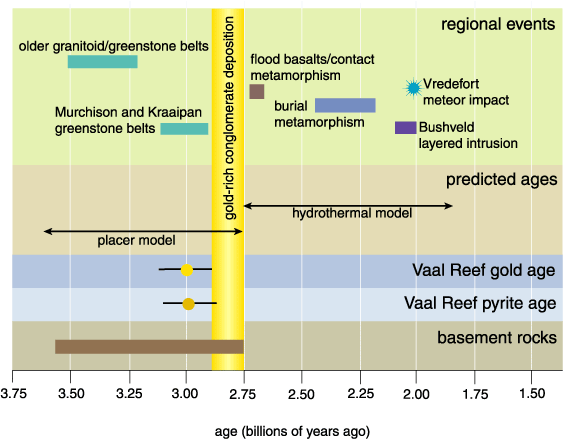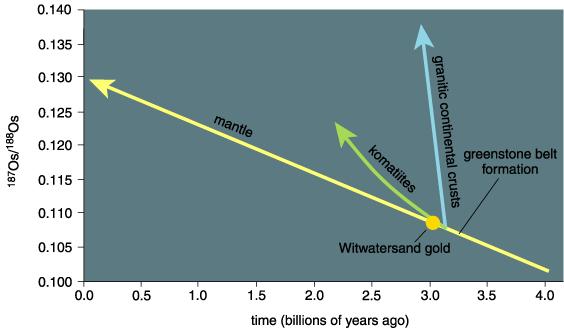The Origin of Gold in South Africa
By Jason Kirk, Joaquin Ruiz, John Chesley, Spencer Titley
Ancient rivers filled with gold, a spectacular upwelling of magma and a colossal meteor impact combined to make the Witwatersrand basin a very special place
Ancient rivers filled with gold, a spectacular upwelling of magma and a colossal meteor impact combined to make the Witwatersrand basin a very special place

DOI: 10.1511/2003.38.534
Crammed shoulder to shoulder with a couple dozen burly miners in an all-too-small elevator, we are about to descend into one of South Africa's largest gold mines. Three men, who must weigh well over 100 kilograms each, lock elbows and heave backwards in unison, forcing us visiting geologists off our feet and farther into the lift.
The gate is forced shut and, as we plummet down the billion-dollar shaft, our ears pop and swirling debris finds its way into our eyes and noses. Two minutes and two vertical kilometers later, we tumble out into oppressive heat and humidity. Walking through enormous tunnels, dodging ore carts and monstrous mining trucks, we reach a series of ski lifts that take us a kilometer deeper. After a long, muddy hike, we near a passage that slopes up at a 20-degree angle and is less than a meter high. Hunched over, we make our way toward the sound of pneumatic drills and water jets, where workers are blasting away at the working face of the mine. More than three kilometers of rock, weighing thousands of tons, lies above our heads. The sedimentary rocks being mined are uninspiring to look at from arm's length—they are what geologists call conglomerates, being composed mostly of rounded pebbles (here consisting predominantly of quartz) cemented together. But under a small magnifying lens, hundreds of small specks of gold appear. The rocks are chock-full of it. Nearly half the gold ever mined in human history has come from these conglomerates in South Africa's Witwatersrand basin.

Photograph courtesy of Jason Kirk.
Small-scale gold prospecting and mining began in this area in the early 1850s, but the first mother lode wasn't discovered until 1885. Two itinerant prospectors, George Walker and George Harrison, stumbled on surface outcrops of gold-rich conglomerate on an old farm—land that is now near the center of Johannesburg. In what must be one of the biggest financial blunders in history, both men quickly sold their claims for the equivalent of a few hundred dollars. Today, the gold fields in the region are worth many billions.
The Witwatersrand basin, which covers an area about the size of West Virginia, contains almost as much gold as the rest of the Earth's surface combined. There is, of course, enormous interest in the origin of these deposits, and more than a hundred years of mining and scientific research have revealed a complex history for these gold-bearing conglomerates. But the chronology of geologic events is imperfectly understood and the ideas about how all this gold came to be here are quite controversial.
Our research group at the University of Arizona has recently taken significant steps toward answering questions about the origin of the Witwatersrand gold. Here we discuss the research and the implications of our results for the geologic history of South Africa.
There are two major hypotheses for the origin of gold within the Witwatersrand basin—the "placer" model and the "hydrothermal" model. Both concepts date back more than 100 years, and each has traded places several times with the other as the favorite among scientists. Determining which of these theories is correct not only concerns earth scientists who wish to unlock the geologic past, but it also has great economic significance for mining companies. The exploratory strategies for gold within the Witwatersrand basin and other parts of the world are continually being modified according to current scientific models.

Emma Skurnick
Everyone agrees that the sediments of the Witwatersrand were originally carried in by a system of braided rivers that eroded material from the surrounding highlands and deposited clay, sand and gravel at the edge of an inland sea (or possibly a great lake). As the rivers emptied into this vast body of water, heavier sediments, such as large quartz pebbles and heavy minerals, settled first, building gravel-rich deltas close to the shoreline, whereas sand and clay were carried farther out to greater depths. Over millions of years, fluctuations in sea level continued to change the position of the river-sea interface causing the deltaic gravels to be covered by sand and clay layers, which were in turn covered by other gravels, and later more sand and clay. This sequence grew many kilometers thick and was then overlaid by large eruptions of lava (called flood basalts) and more sediment. The weight of these layers provided the heat and pressure necessary to transform the unconsolidated sediments into coherent sedimentary rocks.
The placer model holds that these rivers carried small grains of gold and rounded pyrite ("fool's gold") into the basin. Because of their high density, the gold and pyrite fell out of suspension with the larger quartz pebbles in the gravel-rich deltas, and these deposits were eventually transformed into the conglomerates being mined today.
The hydrothermal model states that the sediments that washed into the basin contained very little or no gold. Instead, gold-rich hot fluids emanating from deep within the Earth's crust, and traveling along faults and fractures, added gold to the basin long after the sediments consolidated into rock. The gold precipitated from these fluids along chemically favorable horizons within the basin, corresponding to the layers of conglomerate.

Photograph courtesy of Jason Kirk.
Both theories agree that most of the gold appears to be hydrothermal—it is concentrated in small fractures and around pyrite and carbon within the conglomerates. So, on the face of it, the hydrothermal camp seems to have a fairly strong case. But, as we shall see, all that glitters may not be hydrothermal, and the real answer may require some further geological sleuthing.
Indeed, dozens of scientific papers in the past two decades have offered numerous lines of evidence for (or against) each of the two models. One important observation is that gold is confined almost exclusively to the conglomerates. Supporters of the placer model argue that this correspondence shows that the gold was deposited under the transition from high fluid energy to low, which caused the gravel of the conglomerates to accumulate beneath the river deltas. Supporters of the hydrothermal model counter that the conglomerates fracture more readily than other rocks under the stress of tectonic forces, and the resulting cracks would therefore provide the best conduits for gold-bearing fluids. In this view, carbon and iron in the conglomerates change the local oxidation state of the fluid and act as precipitation sites, bringing the gold out of solution.
Another interesting observation is that much of the pyrite associated with the gold in the conglomerates, and some of the gold grains themselves, are rounded. In the placer model, rounded pyrite and gold result from abrasion during stream transport and wind action during deposition. In the hydrothermal model, dissolved sulfur in the hydrothermal fluids would react with rounded iron-oxide mineral grains (magnetite), replacing the oxygen in the minerals with sulfur, and creating rounded pyrite. Most proponents of this model dispute the existence of rounded gold grains.
Because observations such as these can accommodate either model, a "smoking gun" is needed to choose between the two theories. One possibility is to determine when the gold was mineralized. If the gold grains are older than their host conglomerate, then they must have come from a source that predated the sedimentation. In this view river waters eroded the gold from older source terrains and transported it, along with other sediments, into the basin—the placer model. If the gold grains are younger than their host rocks, then hot groundwater must have added them after the conglomerates were deposited—the hydrothermal model.
The test sounds simple, but gold mineralization has been notoriously difficult to date directly. Previous attempts have relied on dating minerals that often coexist with gold, such as mica, pyrite or uraninite. These ages are used as proxies for the age of the gold but may in fact date events millions of years before or after the gold was actually formed.

Emma Skurnick
Using other minerals to date the gold has been especially problematic in the Witwatersrand basin. Some materials associated with the Witwatersrand gold give ages older than the host conglomerates whereas others give younger ages. Pyrite is a good example; it is intimately associated with gold in the Witwatersrand conglomerates and mining geologists often associate large abundances of pyrite with high-grade gold. We have determined that the ages of rounded, compact pyrite grains are older than the host conglomerates, supporting ages determined by other workers and the supposition that they were rounded by stream transport. Cubic crystals of pyrite, which are almost certainly hydrothermal in origin, give less precise but younger ages than the conglomerates. Both types of pyrites are spatially associated with the gold and both can be used to support either model of gold deposition.
Gold grains are difficult to date because they are composed primarily of elemental gold and minor amounts of silver and mercury and even lesser amounts of bismuth, selenium, platinum group elements and other metals, such as rhenium. Most of these elements are isotopically stable, so dating techniques that rely on the radioactive decay of one element into another are not possible. The lone exception is an isotope of rhenium, rhenium–187 (187Re), which radioactively decays over time into Osmium–187 (187Os) at a known rate. New analytical techniques now allow measurements of the extremely small amounts of rhenium and osmium found in gold, making it possible to determine its age directly.
We recently employed this method to determine a very precise age for gold grains from the Vaal Reef conglomerate of the Witwatersrand basin. It turns out that the gold minerals are 3.01 billion years old—significantly older than the host conglomerates, which are 2.76 to 2.89 billion years old. The result supports theories for a placer origin of gold in the Witwatersrand basin. We now believe there is little doubt that rivers and streams carried the gold into the Witwatersrand basin, probably in quantities that were unique in geologic history.
This leaves us with the question of where this vast amount of gold came from in the first place. For contemporary gold-rich stream sediments it is sometimes possible to follow the stream back to where the gold is being eroded. Likewise, by looking at features such as the size and orientation of the pebbles and orientations of sedimentary features within the conglomerates, scientists have been able to reconstruct the drainage patterns of the Witwatersrand basin. These studies reveal that ancient river systems brought the gold and the sediments primarily from the north and the west. Despite years of intense exploration, however, geologists have failed to locate the figurative mountain of gold at these primordial headwaters.

Emma Skurnick
As it happens, the rhenium and osmium isotopes may also help identify the source of the gold—whether it comes from the Earth's crust or from below that, somewhere in the mantle. The method we used to determine the age of the gold gives two additional pieces of information: the initial composition of the osmium isotopes and the concentration of rhenium and osmium in the gold. For ease of measurement and comparison, 187Re and 187Os (which is the daughter isotope produced by the decay of 187Re) are referenced to a stable isotope of osmium, 188Os. The more rhenium a rock or mineral contains initially, and the older it is, the higher the resulting 187Os/188Os ratio. Therefore, we can find an age for the formation of the gold by measuring the 187Re/188Os and the 187Os/188Os ratios in the gold today. We can also calculate the 187Os/188Os ratio for when the gold was formed—the so-called initial Os isotopic ratio, 187Os/188Osi. The 187Os/188Osi ratio at the age of formation can then be compared to the 187Os/188Os ratio of different crustal rocks and the mantle of the same age.

Photograph courtesy of Jason Kirk.
It turns out that the mantle has relatively low amounts of rhenium compared with osmium, whereas the crust generally has higher amounts. This is because crustal rocks are the products of partial melting of the mantle (and potentially re-melting of previously formed crust) and rhenium goes more readily into the melt. So as crust evolves, it develops 187Os/188Os ratios much greater than the mantle over the same time frame. In a few tens of millions of years, the 187Os/188Os ratio of the mantle and the crust diverge rapidly. Most crustal rocks develop elevated 187Os/188Os ratios quickly, whereas the 187Os/188Os ratios of the much more voluminous mantle change very little. Thus gold that originated from the mantle will have a very different osmium "fingerprint" compared with gold derived from crustal rocks.

Emma Skurnick
The 187Os/188Os ratio of the three-billion-year-old gold from the Witwatersrand basin is the same as that of the Earth's mantle three billion years ago. It has long been recognized that episodes of metamorphism caused by various tectonic events have led to infiltration of hydothermal fluids throughout the basin. These tectonic events mobilized fluids from within the continental crust between 2.7 and 2.0 billion years ago. If these hydrothermal fluids, which originated in the crust, had deposited the Witwatersrand gold, then osmium in these fluids and gold that was precipitated from the fluids should contain elevated 187Os/188Os ratios, much as the crustal rocks themselves. But the Witwatersrand gold has low 187Os/188Os values, much like that of the three-billion-year-old mantle, suggesting that Witwatersrand's gold was not originally derived from normal crust. Instead, it originated directly from the mantle or from a particular class of rocks called komatiites, which are rich in magnesium and sulfur and are made from upper mantle that was melted at very high temperatures.
Furthermore, the mineralized Witwatersrand gold has very high concentrations of both rhenium and osmium relative to younger conglomerate-hosted gold deposits, hydrothermal deposits and average concentrations in the continental crust. Gold from the Witwatersrand basin has rhenium and osmium concentrations that show a very clear affinity with mantle samples and with komatiites. Komatiites were formed almost exclusively in the Archaean Era—2.5 billion years ago and older—and are found predominantly in the ancient centers of the continents. Even though komatiites are crustal rocks in the strict sense, the high-temperature conditions associated with their genesis also causes a high proportion of the mantle to melt, and so imparts mantle-like characteristics to the komatiites. This includes qualities such as relatively high proportions of gold, other platinum group elements and osmium with mantle-like 187Os/188Os ratios.

Emma Skurnick
The sediments found in the Witwatersrand basin are made up of minerals that have long been recognized to originate from granite-greenstone belts—terrains made up of greenstone, a metamorphosed basalt or komatiite, and intruded by granite domes. The nature of the sediments and the mantle-like osmium concentration and composition of the gold, make the gold-bearing komatiites our favored source for the Witwatersrand gold.
There are two areas that might serve as the source of these komatiites: the Kraaipan granite-greenstone belt and the Murchison granite-greenstone belt. These belts are found to the west and the north of the Witwatersrand basin—exactly where reconstructions of the river drainage patterns suggest they should be. Moreover, many of the rocks in these belts are approximately the same age as the Witwatersrand gold, about three billion years. We are currently analyzing gold from within the Kraaipan and Murchison rocks and this should soon determine whether it is also the same age and composition as the Witwatersrand gold.
Will a close age correspondence start a new gold rush to these terrains of South Africa? This seems unlikely. The rocks of the Kraaipan and Murchison belts contain only slightly elevated concentrations of gold relative to normal crust, and they are not rich enough to be of much economic interest on their own. The low concentrations of gold in these granite-greenstone belts suggest that the gold-rich parts have already been eroded away or that younger rocks cover them or that the Witwatersrand's depositional processes (wind and wave action) concentrated the available gold.

Emma Skurnick
There are other places in the world—for example, in Jacobina, Brazil, and Blind River, Canada—with conglomerate formations that are almost identical to the Witwatersrand conglomerates, except that they are younger and have much smaller quantities of gold. Did these other deposits simply lack the gold-rich source terrains that fed the Witwatersrand basin? The source rocks for these younger conglomerate deposits are also granite-greenstone terrains, but they are hundreds of millions of years younger than the Witwatersrand source rocks. The Earth's mantle loses heat exponentially and so younger greenstone terrains form from melting much smaller proportions of the solid mantle at lower temperatures. A higher percentage of mantle melting may imply that more gold can go into the melt. Is the richness of the Witwatersrand source rocks simply a result of their age? We don't know the answers yet.
The new evidence from our rhenium and osmium analyses and the work of many others provides a clearer picture of the history of gold mineralization in the Witwatersrand basin. Scientists now know that volcanic eruptions and granitic intrusions produced the nuclei of the South African continental crust—such as the Barberton granite-greenstone belt—over three and a half billion years ago. These terrains provided a foundation on which other volcanic arcs and plateaus were progressively accreted through the action of plate tectonics. The Kraaipan greenstone belt and the Murchison greenstone belt were two of the terrains (approximately 3.1 to 2.7 billion years old) that were plastered onto the northern and western portions of the continental nucleus. The region of the mantle that fed these terrains may have been extremely rich in gold or the melting processes that generated the komatiites may have been exceptionally efficient at extracting gold out of the mantle rock. After the Kraaipan and Murchison greenstone belts attached themselves to the continental nucleus, the crust became stable enough to form one of the world's first large sedimentary basins. Waters flowing from the high relief of these terrains carried gold into the neighboring inland sea.

Emma Skurnick
By placing age constraints on the mineralization of the Witwatersrand basin, and by confirming the sedimentary nature of the gold, our work adds information to current debate regarding studies of the nature of the Archaean atmosphere—the era when the sediment was transported and deposited. The presence of uranium minerals and pyrite in the sediments suggests that the atmosphere was very different 2.9 to 2.7 billion years ago. In today's environment, minerals such as pyrite and uraninite are unstable because of atmospheric oxygen and do not survive long in surficial waters. Extremely low concentrations of oxygen in the atmosphere are required for pyrite and uranium minerals to be stable in surficial waters. This supports current theories based on Precambrian iron deposits, oxidized sandstones and ancient soils, which suggest that oxygen was not abundant in the Earth's atmosphere in the Early Archaean and did not reach present-day levels until much later.
Approximately 2.7 billion years ago, the supply of sediments into the basin ended as voluminous flood basalts covered the Witwatersrand basin. More than seven kilometers of sedimentary rocks interspersed with gold-rich conglomerates were buried beneath several more kilometers of lavas and other rocks. This progressive burial eventually produced enough pressure and heat to squeeze water out of the sediments—compacting, cooking and cementing the sediments into rock. The fluids released by burial may have dissolved some of the originally sedimentary gold and moved it over very short distances, while leaving some of the gold untouched. This is evident by the presence of both gold grains with rounded disk-like shapes (which are sedimentary) and gold grains with irregular dendritic shapes (which are hydrothermal).
Partial dissolution of the gold and local re-precipitation not only explains the two different morphologies of gold, but also helps explains why the rhenium-osmium clock wasn't reset by this local mobilization. Rhenium and osmium are generally very insoluble and therefore, hydrothermal fluids contain very low concentrations and transport only small amounts of these elements. Witwatersrand gold on the other hand has orders of magnitude higher concentrations of rhenium and osmium relative to hydrothermal fluids and crustal rocks. Therefore almost all of the rhenium and osmium would stay with the undissolved gold and it would therefore retain the three-billion-year age. The age of the gold that was locally mobilized would be reset and be much younger than that of the undissolved gold. However, because of the extreme differences in osmium concentration between the placer gold and the mobilized gold, the rhenium-osmium clock would not be affected and all of the gold would appear to have the three-billion-year-old age.
Two other events that transpired well after the gold was deposited may help explain why South Africa is so rich in valuable minerals. The first was a large upwelling of magma from the mantle about 100 kilometers northeast of the Witwatersrand basin, which resulted in the Bushveld igneous complex, the world's largest source of platinum and chromium. This event also triggered fluids to move through the conglomerates of the Witwatersrand basin once again and may have moved some of the gold very short distances.
The second event took place about 30 million years after the emplacement of the Bushveld: A huge meteor slammed into the sedimentary rocks at the center of the Witwatersrand basin. This collision was larger than the dinosaur-killing impact that produced the Chicxulub crater in Mexico. The South African blast brought up rocks from the lower crust and upper mantle and tilted the layers of the basin. The tilting of the gold-bearing sedimentary layers may have helped partially preserve these rocks from later erosion until the present day.
Since those two events the continental crust of South Africa has been geologically stable. The gold-rich conglomerates waited undisturbed for billions of years until prospectors discovered the tip of a gold iceberg, now being explored by tens of thousands of mine workers laboring in the deepest holes on Earth.
The authors would like to thank our lab manager Mark Baker. Fernando Barra, Victor Valencia, Ryan Mathur, Hartwig Frimmel, Laurence Robb and John Walshe provided helpful discussions. The mine workers, geologists and management of the Witwatersrand gold mines provided access to and help with sample collections and context. Wolf Reimold and The Council for Geosciences, South Africa hosted an illuminating field trip to the Vredefort impact structure. We are especially grateful to Greg Hall and Tony Harwood of Placer Dome and Nic Fox of AngloGold and their companies for supporting our fieldwork, as well as access to the mines and for the exchange of ideas. These studies were supported in part by the NSF.
Click "American Scientist" to access home page
American Scientist Comments and Discussion
To discuss our articles or comment on them, please share them and tag American Scientist on social media platforms. Here are links to our profiles on Twitter, Facebook, and LinkedIn.
If we re-share your post, we will moderate comments/discussion following our comments policy.